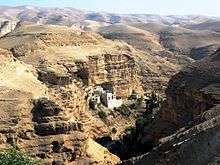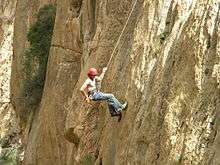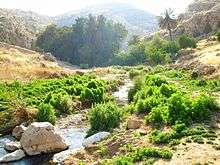Wadi Qelt



Part of a series on the |
|---|
| History of Palestine |
-Jerusalem-Temple_Mount-Dome_of_the_Rock_(SE_exposure).jpg) |
| Prehistory |
| Ancient history |
| Classical period |
| Islamic rule |
| Modern era |
|
|
Wadi Qelt (Arabic: وادي القلط; also: Wadi al-Qult, Wadi el-Qult, Wadi Kelt, Wadi Qilt or Wadi Qult), also Nahal Prat (Hebrew: נחל פרת), is a valley or stream (Arabic: وادي wādī, "wadi"; Hebrew: נחל, "nahal") in the West Bank, originating near Jerusalem and terminating near Jericho, near the Dead Sea, where it runs into the Jordan River.
Wadi Qelt is home to a unique variety of flora and fauna. St. George's Monastery and the Wadi Qelt Synagogue are located in the Wadi, which has been identified with the biblical Perath mentioned in Jeremiah 13:5.[1]
History
Ancient history
Wadi Qelt contains monasteries and old Christian locations. Several aqueducts have been found along the stream, the oldest dating to the Hasmonean period (2nd century BC).[2] The aqueducts transported water from three main springs in the valley to Jericho.[3] The Wadi Qelt Synagogue, built as part of a Hasmonean royal winter palace, is believed to be one of the oldest synagogues in the world.[4][5] The site was home to the winter palaces of Hasmonean kings and Herod the Great.[6]
Qubur Bani Isra'in are huge stone structures which rise from a rocky plateau overlooking Wadi Qelt.[7]
The Monastery of Saint George was founded by John of Thebes around 480 AD, and it became an important spiritual centre in the sixth century under Saint George of Choziba. Hermits living in caves in nearby cliffs would meet in the monastery for a weekly mass and communal meal.[8]
Modern times
The area was occupied by Israel in 1967, and hence parts of the wadi were declared a nature reserve, the Ein Prat Nature Reserve.[9]
Wadi Qelt is a popular route for Palestinian and Israeli hikers. It is possible to hike all the way from the town of Hizma to Jericho, a journey of 25 kilometres and an 850m descent.[10] The wadi is used by many Bedouin shepherds.
On December 20, 1968, Israeli lieutenant-Colonel Zvi Ofer (Tzvika Ofer), commander of the elite Haruv unit, former Military Governor of Nablus and recipient of the Israeli medal of valour, was killed in action in Wadi Qelt while pursuing Arab militants who had crossed the Jordan.[11]
Wadi Qelt was the site of several Palestinian terror attacks on Israeli hikers following the 1993 Declaration of Principles peace agreement between Israel and the PLO. Dror Forer and Eran Bachar were shot to death on October 9, 1993, Ori Shahor and Ohad Bachrach were shot and killed on July 18, 1995, and Hagit Zavitzky and Liat Kastiel were stabbed and killed on April 25, 1997.[12]
See also
References
- ↑ "Wadi Qilt". bibleplaces.com.
- ↑ "En Prat Nature Reserve". allaboutjerusalem.com.
- ↑ Gruber, Angela (3 April 2015). "In the occupied West Bank, even hiking is political". +972 mag. Retrieved 2 March 2016.
- ↑ Oldest Synagogue Found in Israel, March 29, 1998. Associated Press
- ↑ Israel's Oldest Synagogue, Archaeology, Volume 51 Number 4, July/August 1998, Spencer P.M. Harrington
- ↑ "Jericho - The Winter Palace of King Herod - Jewish Virtual Library". jewishvirtuallibrary.org.
- ↑ "The Tombs of the Children of Israel". goisrael.com.
- ↑ Palestine & Palestinians. Beit Sahour: Alternative Tourism Group. September 2008. p. 181. ISBN 9950-319-01-3.
- ↑ "En Prat Nature Reserve". allaboutjerusalem.com.
- ↑ Szepesi, Stefan (2012). Walking Palestine: 25 Journeys Into The West Bank. Oxford: Signal. p. 201. ISBN 978-1-908493-61-3.
- ↑ Teveth, Shabtai (1969/1970) The Cursed Blessing. The story of Israel's occupation of the West Bank. Weidenfield & Nicolson. SBN 297 00150 7. Translated from Hebrew by Myra Bank. Page 347.
- ↑ "Comprehensive Listing of Terrorism Victims in Israel - Jewish Virtual Library". jewishvirtuallibrary.org.
External links
![]() Media related to Wadi Qelt at Wikimedia Commons
Media related to Wadi Qelt at Wikimedia Commons
Coordinates: 31°50′40″N 35°24′51″E / 31.844316°N 35.414257°E